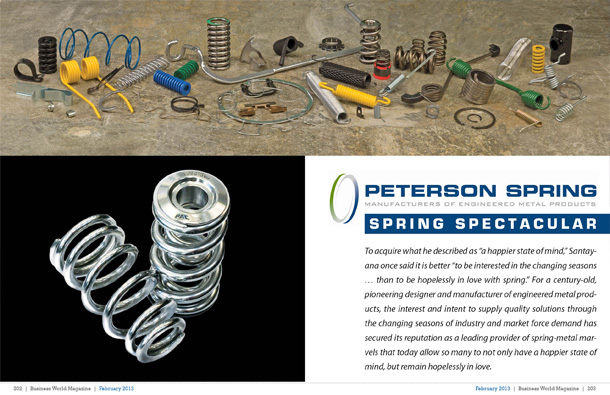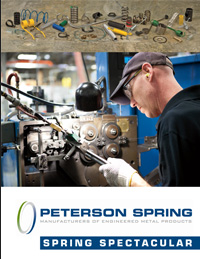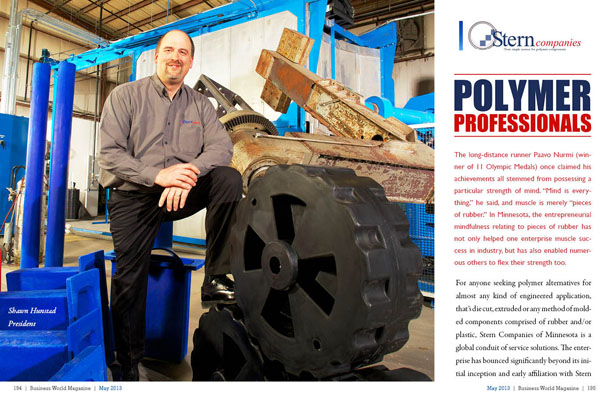

To acquire what he described as “a happier state of mind,†Santayana once said it is better “to be interested in the changing seasons … than to be hopelessly in love with spring.†For a century-old, pioneering designer and manufacturer of engineered metal products, the interest and intent to supply quality solutions through the changing seasons of industry and market force demand has secured its reputation as a leading provider of spring-metal marvels that today allow so many to not only have a happier state of mind, but remain hopelessly in love.  Â
Consider for a moment, the cheering droves of spectators that revel in the rocket-like blast off from their favorite Formula-1 or drag strip racer, or maybe, reflect upon those passengers relieved when the airplane’s landing gear deploys to mark the end of a long journey. Consider shorter passages, in the up-and-down excursions made on an elevator, or even, the simple yet strangely satisfying, back-and-forth rocking allowed by your favorite office chair. Within each of these instances, the functionality of the mechanism involved is totally dependent on smaller, often obscured parts that have been specifically designed for a particular application. In all of the noted cases, the applications have been augmented by innovations of a Michigan-based company known as Peterson Spring. While their products are visible in a variety of industries, average consumers may not immediately recognize the extent to which this company operates. From the engine valve springs in automobiles, jet skis and motorcycles, to components that allow the oven or dishwasher drawer to gently open and close, from the spring clips and wire forms applied to wheel chairs or hospital beds, to the springs that add functionality to elevators, agricultural equipment, washing machines and dock levelers. Their products can range in sophistication from that used in airplanes and engines of the National Hot Rod Association to something as simple and familiar as that grip throttle on the lawnmower. To put it plainly, Peterson Spring spirals into almost every aspect of daily human existence.
Despite the corporate name, Senior Vice President of Sales and Marketing Don Lowe, is quick to dismiss any notions that the company solely specializes in the manufacturing of springs. “We don’t just make springs. We are a designer and manufacturer of engineered metal products, which includes springs, wire forms, spring-steel clamps and hose clamps, retaining rings… everything we make has been engineered for a specific application,†says Lowe.
Insisting on Excellence
To provide insight on the company’s engineering capabilities, Ron Check (the Vice President who leads Corporate Engineering and Technology) begins a lecture detailing distinctions in the metallurgical modalities among spring varieties categorized in terms of torsion, extension or compression dynamics. While not really as confusing as it may sound, there is somewhat more comprehensible truth in Check’s assertion, “It’s not just bent wire.â€
To appreciate the depth of that comment requires his further explanation as to how products have to be engineered with standards of precision customized for the application. For example, the engine valve springs they manufacture for the automobile industry is very different from that manufactured for vehicles in the racing industry. Check says drag racers require valve springs that can withstand bursts from “a hell of a lot of force†for a short duration. On other racing circuits, those valve springs have to be customized for endurance, allowing the driver to complete 500 miles on a round track. The properties are different, but in either case, should the valve spring malfunction causing the valve to drop, the engine is thereby ruined, corporate sponsors are miffed, and thousands of fans are left dismayed that their favorite driver failed to claim the checkered flag. All for the want of a quality valve spring. It would also be disappointing to jump on a trampoline without the benefit of Peterson Spring’s extension springs (cylindrical model with hook at each end) that connect the mat to a frame creating tension that ultimately facilitates the bounce into the air. Without such, there can be no jump for joy. Of course, the implications are much graver when encountering a faulty elevator or airplane landing gear. The fact that so many rely on the dependability, durability and quality exacted through the critical expertise of Peterson Spring, goes a long way toward validating the firm’s position as the go-to authority for engineered metal mastery.
 And regardless of the application, Peterson Spring employs the full measure of its talent and engineering tenacity to provide the customized designs, manufactured materials, and responsive service in such a way as to not simply get a passing grade, but outscore everyone else in industry. As Don Lowe explains, “We have a mantra here and it appears on every presentation… it is living mantra carried in the heart of every employee, which says ‘Discipline in all we do’ … we emphasize integrity and we insist on excellence. For us, satisfying a customer isn’t good enough. We strive to exceed expectations in product quality, delivery, service… we want to earn an A+.â€
Back to the Future
For a company that has been in operation for 100 years, Lowe makes a point about certain signage that refers to “billions served,†saying, “I don’t know how many billions of springs we’ve made, but it definitely is in the billions.â€
That all began in 1914 with a Norwegian immigrant and blacksmith named August Peterson. He arrived in Michigan and produced goods that served in the burgeoning railroad and automotive industry. Three generations of Peterson descendents would go on to run the company up until 2008. While Peterson’s progeny still sit on the company’s board of directors, in 2008, they recruited a six-member management team to guide the company’s future. With the exception of the CFO, all had backgrounds in engineering. This group, combined with the engineering efficiencies of the existing staff, can claim the lion’s share of credit for the company’s current diversified, if not dominating, emergence in so many industries.
As Lowe says, “This brought in a fresh set of eyes, a collage of learning and knowledge from different backgrounds, which could be brought to the organization and used as a means of growing the organization to the next level.â€
Check, who has been with the company for almost 20 years, explains the transition this way: “What I saw in the older family-style of operations, divisions were being run as individual, autonomous profit centers. The new management team centralized operations, created a standardization in quality systems, cost estimating systems, and communications… where before, each division may have adopted own practices, but now those are shared so we can grab common efficiencies… from a technology perspective… as a solution is to share, so that other divisions gain those efficiencies as well.†The team took further steps by investing in technology and equipment to provide dynamic engineering, tools and resources.
A critical component was creating a five year strategic plan, designed as Lowe says, “to go from good to great.†Strategies were specifically created to accomplish goals in terms that included sales growth, operational excellence, communication and more. From the vantage of sales, Lowe explains critical reasoning of that time. “For example, we recognized that we’re already making engine valve springs for General Motors. We like that business, and that customer likes us. Why not make them for other OEMs? And why not for other applications, like marine engines, snow mobiles, jet skis… our objective was to go and get that business, and we’ve been successful at it.â€
They would prove further success at reinvigorating company-wide morale and foster faith that all are accountable (and capable) of creating innovation that can help better the company. Today, this is something measured during annual performance reviews. “This company is actually hungry for innovation from everyone in the organization… doesn’t matter whether you’re executive in a carpeted office, engineer or the guy who puts paint on the rails. We asked, “What is it about each one of us that can help compel the company into the future with distinction?†says Lowe.
He credits this philosophical transition to greater efficiencies, greater productivity and greater innovation, and has even helped retain employees which Lowe says are today more focused and more interested in securing future success.
From Bounce to Pounce
Peterson Spring has expanded well beyond their base in the United States, having additional plants today in the United Kingdom, Canada and Mexico. Lowe holds his cards close to chest but acknowledges the company is currently exploring opportunities in South America as well as Asia. Between agricultural and automotive opportunities, he indicates Peterson Spring is looking to fulfill needs in these markets.
Beyond that growth, the company continues to devise solutions that meet the changing demands of industrial and automotive needs, just as it always has. As Check says, cars today are nothing like the cars of yesterday, when engines had less quality, tolerances were looser and materials not as well developed. “Engines have gone through an evolution, and are much more complex… they also have much different valve springs which have higher performance requirements. And now, with mandated fuel economy, there’s a whole lot more technology going in to squeeze out every drop of fuel.â€
The company is currently partnered in a project which may lead to the development of new products, made from new materials, with physical properties that may potentially lead to greater efficiencies in this segment of industry. In designing and manufacturing precision materials that serve in the racing industry, Peterson Spring has been able to adapt those innovations to benefit other industries, and Lowe says this factor will help drive further success for the company. He is also encouraged by current market dynamics, which have shifted from not so long ago when companies began relying more on foreign manufacturers in an attempt to save money. As Lowe says, “We have seen some business lost to Asia, but we have also won some business in Asia. In the past, some customers moved their business overseas for the cost advantage, but found, after a couple years, those cost advantages erode, because wages have gone up, transportation costs have gone up, and their quality is going down. The value that was perceived to be there is gone.â€
In recent years, he says the company has seen business returning to America. While that has worked to the company’s advantage, so too have conditions relating to economic downturn. Lowe says the great recession ultimately eliminated some competition and there are, overall, fewer spring makers operating than there were in 2007. “The strong survived and got stronger as a result,†says Lowe.
By continuing to foster innovation from all employees, invest in state-of-the-art technology and tools that facilitate new applications for their products, and maintaining undeterred discipline in all aspects of service and production, Lowe says Peterson Spring is poised to brilliantly build upon their 100 year legacy of performance. And in this case, that confidence and faith is much like one poet’s reference to hope  – it springs eternal.








